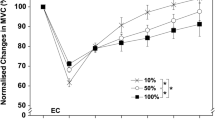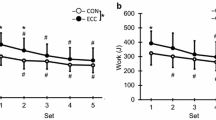Abstract
This study compared between maximal voluntary (VOL) and electrically stimulated (ES) isometric contractions of the elbow flexors for changes in indirect markers of muscle damage to investigate whether ES would induce greater muscle damage than VOL. Twelve non-resistance-trained men (23–39 years) performed VOL with one arm and ES with the contralateral arm separated by 2 weeks in a randomised, counterbalanced order. Both VOL and ES (frequency 75 Hz, pulse duration 250 μs, maximally tolerated intensity) exercises consisted of 50 maximal isometric contractions (4-s on, 15-s off) of the elbow flexors at a long muscle length (160°). Changes in maximal voluntary isometric contraction torque (MVC), range of motion, muscle soreness, pressure pain threshold and serum creatine kinase (CK) activity were measured before, immediately after and 1, 24, 48, 72 and 96 h following exercise. The average peak torque over the 50 isometric contractions was greater (P < 0.05) for VOL (32.9 ± 9.8 N m) than ES (16.9 ± 6.3 N m). MVC decreased greater and recovered slower (P < 0.05) after ES (15% lower than baseline at 96 h) than VOL (full recovery). Serum CK activity increased (P < 0.05) only after ES, and the muscles became more sore and tender after ES than VOL (P < 0.05). These results showed that ES induced greater muscle damage than VOL despite the lower torque output during ES. It seems likely that higher mechanical stress imposed on the activated muscle fibres, due to the specificity of motor unit recruitment in ES, resulted in greater muscle damage.





Similar content being viewed by others
References
Aagaard P, Simonsen EB, Andersen JL, Magnusson P, Dyhre-Poulsen P (2002) Increased rate of force development and neural drive of human skeletal muscle following resistance training. J Appl Physiol 93:1318–1326
Adams GR, Harris RT, Woodard D, Dudley GA (1993) Mapping of electrical muscle stimulation using MRI. J Appl Physiol 74:532–537
Aldayel A, Jubeau M, McGuigan MR, Nosaka K (2010) Less indication of muscle damage in the second than initial electrical muscle stimulation bout consisting of isometric contractions of the knee extensors. Eur J Appl Physiol 108:709–717
Alon G, Smith GV (2005) Tolerance and conditioning to neuro-muscular electrical stimulation within and between sessions and gender. J Sports Sci Med 4:395–405
Armstrong RB (1984) Mechanisms of exercise-induced delayed onset muscular soreness: a brief review. Med Sci Sports Exerc 16:529–538
Bax L, Staes F, Verhagen A (2005) Does neuromuscular electrical stimulation strengthen the quadriceps femoris? A systematic review of randomised controlled trials. Sports Med 35:191–212
Black CD, Elder CP, Gorgey A, Dudley GA (2008) High specific torque is related to lengthening contraction-induced skeletal muscle injury. J Appl Physiol 104:639–647
Crameri RM, Aagaard P, Qvortrup K, Langberg H, Olesen J, Kjaer M (2007) Myofibre damage in human skeletal muscle: effects of electrical stimulation versus voluntary contraction. J Physiol 583:365–380
Desbrosses K, Babault N, Scaglioni G, Meyer JP, Pousson M (2006) Neural activation after maximal isometric contractions at different muscle lengths. Med Sci Sports Exerc 38:937–944
Fleck SJ, Kraemer WJ (2004) Types of strength training. In: Designing resistance training programs, 3rd edn. Human Kinetics, Champaign, pp 13–52
Gregory CM, Bickel CS (2005) Recruitment patterns in human skeletal muscle during electrical stimulation. Phys Ther 85:358–364
Jones DA, Newham DJ, Torgan C (1989) Mechanical influences on long-lasting human muscle fatigue and delayed-onset pain. J Physiol 412:415–427
Jubeau M, Gondin J, Martin A, Sartorio A, Maffiuletti NA (2007) Random motor unit activation by electrostimulation. Int J Sports Med 28:901–904
Jubeau M, Sartorio A, Marinone PG, Agosti F, Van Hoecke J, Nosaka K, Maffiuletti NA (2008) Comparison between voluntary and stimulated contractions of the quadriceps femoris for growth hormone response and muscle damage. J Appl Physiol 104:75–81
Lavender AP, Nosaka K (2008) A light load eccentric exercise confers protection against a subsequent bout of more demanding eccentric exercise. J Sci Med Sport 11:291–298
Lieber RL, Kelly MJ (1991) Factors influencing quadriceps femoris muscle torque using transcutaneous neuromuscular electrical stimulation. Phys Ther 71:715–721 (discussion 722–713)
Lieber RL, Kelly MJ (1993) Torque history of electrically stimulated human quadriceps: implications for stimulation therapy. J Orthop Res 11:131–141
Lieber RL, Woodburn TM, Friden J (1991) Muscle damage induced by eccentric contractions of 25% strain. J Appl Physiol 70:2498–2507
Mackey AL, Bojsen-Moller J, Qvortrup K, Langberg H, Suetta C, Kalliokoski KK, Kjaer M, Magnusson SP (2008) Evidence of skeletal muscle damage following electrically stimulated isometric muscle contractions in humans. J Appl Physiol 105:1620–1627
Maffiuletti NA (2010) Physiological and methodological considerations for the use of neuromuscular electrical stimulation. Eur J Appl Physiol 110:223–234
Manta P, Kalfakis N, Kararizou E, Vassilopoulos D, Papageorgiou K (1995) Distribution of muscle fibre types in human skeletal muscle fascicles: an autopsy study of three human muscles. Funct Neurol 10:137–141
Morgan DL, Whitehead NP, Wise AK, Gregory JE, Proske U (2000) Tension changes in the cat soleus muscle following slow stretch or shortening of the contracting muscle. J Physiol 522(Pt 3):503–513
Nosaka K, Clarkson PM (1996) Changes in indicators of inflammation after eccentric exercise of the elbow flexors. Med Sci Sports Exerc 28:953–961
Nosaka K, Newton M (2002) Difference in the magnitude of muscle damage between maximal and submaximal eccentric loading. J Strength Cond Res 16:202–208
Nosaka K, Sakamoto K (2001) Effect of elbow joint angle on the magnitude of muscle damage to the elbow flexors. Med Sci Sports Exerc 33:22–29
Nosaka K, Newton M, Sacco P (2002) Responses of human elbow flexor muscles to electrically stimulated forced lengthening exercise. Acta Physiol Scand 174:137–145
Nosaka K, Newton M, Sacco P, Chapman D, Lavender A (2005) Partial protection against muscle damage by eccentric actions at short muscle lengths. Med Sci Sports Exerc 37:746–753
Oldfield RC (1971) The assessment and analysis of handedness: the Edinburgh inventory. Neuropsychologia 9:97–113
Paulsen G, Crameri R, Benestad HB, Fjeld JG, Morkrid L, Hallen J, Raastad T (2010) Time course of leukocyte accumulation in human muscle after eccentric exercise. Med Sci Sports Exerc 42:75–85
Peake JM, Nosaka K, Muthalib M, Suzuki K (2006) Systemic inflammatory responses to maximal versus submaximal lengthening contractions of the elbow flexors. Exerc Immunol Rev 12:72–85
Philippou A, Maridaki M, Bogdanis GC (2003) Angle-specific impairment of elbow flexors strength after isometric exercise at long muscle length. J Sports Sci 21:859–865
Proske U, Allen TJ (2005) Damage to skeletal muscle from eccentric exercise. Exerc Sport Sci Rev 33:98–104
Raastad T, Owe SG, Paulsen G, Enns D, Overgaard K, Crameri R, Kiil S, Belcastro A, Bergersen L, Hallen J (2010) Changes in calpain activity, muscle structure, and function after eccentric exercise. Med Sci Sports Exerc 42:86–95
van Bolhuis BM, Gielen CC (1997) The relative activation of elbow-flexor muscles in isometric flexion and in flexion/extension movements. J Biomech 30:803–811
van Zuylen EJ, van Velzen A, Denier van der Gon JJ (1988) A biomechanical model for flexion torques of human arm muscles as a function of elbow angle. J Biomech 21:183–190
Vanderthommen M, Duchateau J (2007) Electrical stimulation as a modality to improve performance of the neuromuscular system. Exerc Sport Sci Rev 35:180–185
Vanderthommen M, Duteil S, Wary C, Raynaud JS, Leroy-Willig A, Crielaard JM, Carlier PG (2003) A comparison of voluntary and electrically induced contractions by interleaved 1H- and 31P-NMRS in humans. J Appl Physiol 94:1012–1024
Warren GL, Lowe DA, Armstrong RB (1999) Measurement tools used in the study of eccentric contraction-induced injury. Sports Med 27:43–59
Warren GL, Ingalls CP, Lowe DA, Armstrong RB (2001) Excitation–contraction uncoupling: major role in contraction-induced muscle injury. Exerc Sport Sci Rev 29:82–87
Acknowledgments
The authors express their gratitude to Dr. Julien Gondin (CRMBM, UMR CNRS 6612, University of the Mediterranean) for his valuable comments on our paper.
Author information
Authors and Affiliations
Corresponding author
Additional information
Communicated by Alain Martin.
Rights and permissions
About this article
Cite this article
Jubeau, M., Muthalib, M., Millet, G.Y. et al. Comparison in muscle damage between maximal voluntary and electrically evoked isometric contractions of the elbow flexors. Eur J Appl Physiol 112, 429–438 (2012). https://doi.org/10.1007/s00421-011-1991-3
Received:
Accepted:
Published:
Issue Date:
DOI: https://doi.org/10.1007/s00421-011-1991-3




